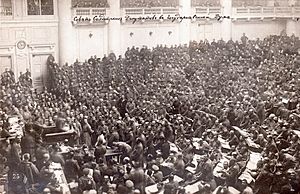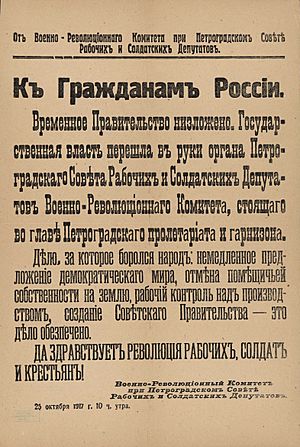Petrograd Soviet facts for kids
Quick facts for kids Petrograd SovietПетроградский совет (Russian) |
|
|---|---|
| City council | |
| Type | |
| Type | |
| History | |
| Established | March 12, 1917 |
| Disbanded | 26 January 1924 |
| Succeeded by | Lensovet |
| Leadership | |
|
Chairman
|
|
| Meeting place | |
 |
|
| St. Petersburg (then Petrograd) | |
The Petrograd Soviet was a very important group of workers and soldiers in Petrograd, which was the capital city of Russia back then. It was officially called the Petrograd Soviet of Workers' and Soldiers' Deputies.
This group was formed in March 1917, right after the February Revolution. It was meant to represent the workers and soldiers of the city. At that time, Petrograd already had a city council, but the Petrograd Soviet became a powerful new group. It tried to spread its influence across the whole country. This created a situation called Dual Power, where the Petrograd Soviet and the Provisional Government both had power. The committees of the Soviet played a big role in the Russian Revolution, and some of them even led the armed uprising of the October Revolution.
Contents
How the Petrograd Soviet Started
Before 1914, Petrograd was known as Saint Petersburg. In 1905, a workers' group called the St Petersburg Soviet was formed. The main group that led to the 1917 Petrograd Soviet was the Central Workers' Group. This group was started in November 1915 by the Mensheviks. Their goal was to help workers and the Central War Industry Committee in Petrograd work together.
As World War I continued and the economy got worse, the Central Workers' Group became more radical. They encouraged street protests and shared revolutionary messages.
On January 27, 1917, the leaders of the Central Workers' Group were arrested. They were taken to the Peter and Paul Fortress. But on February 27, at the start of the February Revolution, soldiers freed them. The chairman of the group quickly called a meeting to organize a Soviet of Workers' Deputies.
That evening, many people met at the Tauride Palace. They chose a temporary executive committee, called the Ispolkom. Nikolay Chkheidze was chosen as its chairman. Most of the members were Mensheviks. Izvestia became their official newspaper. The next day, more representatives from factories and the military joined. In just two weeks, the Soviet had almost 3,000 members, mostly soldiers. The meetings were often messy, but the Ispolkom quickly took charge of making decisions.
Who Led the Petrograd Soviet?
The chairmen of the Petrograd Soviet were:
- Nikolay Chkheidze: From March 12 to September 19, 1917
- Leon Trotsky: From September 25 to October 26, 1917
- Grigory Zinoviev: From December 13, 1917, to March 26, 1926
The Executive Committee (Ispolkom)
The members of the executive committee, or Ispolkom, came from different political groups. Each socialist party had three seats. This meant the committee was made up of smart and radical thinkers, while the main Soviet body had many peasants, workers, and soldiers. The executive committee meetings were often long and intense.
On March 1, the executive committee decided not to join any new State Duma. This allowed them to criticize the government without being responsible for its actions. On March 2, the Soviet gave conditional support to the Provisional Committee of the State Duma. The Soviet also started issuing its own orders, like the famous Order No. 1. This order gave soldiers' committees control over their units' weapons. The Soviet was worried about the military turning against the revolution and wanted soldiers on its side.
Other Important Committees
- Petrograd Military Revolutionary Committee (Milrevkom)
- Committee on Revolutionary Defense
The Power Struggle with the Provisional Government
The Petrograd Soviet became a powerful alternative to the Provisional Government. This government was first led by Prince Georgy Lvov and later by Alexander Kerensky.
This situation was known as dvoevlastie (dual power). The Petrograd Soviet and the Provisional Government both claimed to be in charge. This lasted until the October Revolution.
The Ispolkom often criticized the Provisional Government, calling it "bourgeois" (meaning it represented the middle class, not workers). The Ispolkom boasted that it had real control over things like the post, telegraphs, newspapers, railroads, and food supply. On March 8, a "shadow government" with a Contact Commission was created. Its job was to tell the Provisional Government what the people wanted and make sure those demands were met. By March 19, this control extended to the military front lines.
In March 1917, the Petrograd Soviet faced protests from workers who went on strike. Even the Menshevik newspaper Rabochaia Gazeta said that the strikers were making the Soviet look bad by not obeying it.
The Ispolkom grew to 19 members on April 8. Nine members represented the soldiers, and ten represented the workers. All members were socialists, mostly Mensheviks or Socialist-Revolutionaries. There were no Bolsheviks at this point. After the first All-Russian Congress of Soviets in June/July 1917, the Petrograd Soviet started adding representatives from other parts of Russia. It then changed its name to the All-Russian Soviet of Workers' and Soldiers' Deputies. The executive committee became the All-Russian Central Executive Committee (CEC or VTsIK).
The Rise of the Bolsheviks
The growing influence of the Bolsheviks in 1917 is known as the Bolshevization of soviets. The Bolsheviks quickly became the main opposition group. They used the failures of the Provisional Government to criticize the socialists who were part of it. The Bolsheviks started a strong campaign of propaganda. By June, they were printing 100,000 copies of their newspaper Pravda every day. In July, they handed out over 350,000 leaflets. The July Days riots in July were inspired by the Bolsheviks, but not directly led by them, and they were not successful.
As Alexander Kerensky became more powerful, and after the shock of the Kornilov affair, the political situation became very divided. The Petrograd Soviet moved more towards the left, while other groups supported Kerensky. Even after the July events, the Ispolkom protected the Bolsheviks from serious punishment. They passed resolutions in August against arresting and prosecuting Bolsheviks. The government released many senior Bolsheviks on bail or after they promised to behave.
In the local elections on August 20, the Bolsheviks received a third of the votes. This was a 50% increase in just three months.
During the Kornilov affair, the Ispolkom had to rely on the Bolsheviks' military groups to fight against what they saw as a "counter-revolution." Kerensky even ordered 40,000 rifles to be given to the workers of Petrograd. Many of these rifles ended up with Bolshevik groups, including the Red Guards.
As other socialist parties left the Soviet organizations, the Bolsheviks gained more power. On September 25, they became the majority in the Workers' Section. Leon Trotsky was elected chairman. He then guided the Soviet to become a revolutionary group that followed Bolshevik ideas.
The October Days of 1917

On October 6, with German forces threatening Petrograd, the government planned to move to Moscow. The Ispolkom strongly opposed this. Trotsky got the soldiers' section to vote against the evacuation. The Provisional Government then put off the evacuation. Its attempts to send Petrograd soldiers to the front lines were resisted by the troops and the Ispolkom.
On October 9, the Soviets discussed creating a Committee of Revolutionary Defense. The Bolsheviks and Trotsky changed the plan to include protecting Petrograd from both German and internal threats. The Soviet voted for a committee to "gather... all the forces participating in the defense of Petrograd... to arm the workers... ensuring the revolutionary defense of Petrograd... against the... military and civilian Kornilovites."
The Ispolkom approved this plan on October 12, despite resistance from the Mensheviks. The Soviet approved it on October 16, creating the Military Revolutionary Committee (Voenno-Revoliutsionnyi Komitet), also called the Milrevcom.
The Military-Revolutionary Committee was led by Pavel Lazimir, with Nikolai Podvoisky as his deputy. It was a way for the Bolsheviks' Military Organization to carry out its activities. Podvoisky took official control of the committee on the day of the uprising. The Ispolkom and the Provisional Government had lost control of the military forces in Petrograd.
On the night of October 21, the Milrevcom took full control of the soldiers in the city. The military commander, Colonel Polkovnikov, refused to allow this. He and his staff were called "a direct weapon of the counter-revolutionary forces" by the Milrevcom. The military command responded with an ultimatum, leading to talks on October 23 and 24.
The Bolshevik uprising began on October 24. "Liberal" forces tried to shut down Pravda and take other steps to secure the government. The Milrevcom sent armed groups to seize the main telegraph offices and lower the bridges across the Neva River. That night, the Bolsheviks quickly took control. Most of the guards and workers had sided with them and helped with the Milrevcom's plans.
The next morning, at 10 am, the Milrevcom announced that the Provisional Government was over and power had been transferred to the Petrograd Soviet. This announcement was written by Vladimir Lenin. Later that afternoon, Trotsky called an emergency meeting of the Petrograd Soviet. It was filled with Bolsheviks and Left SR members.
That evening, the Second Congress of Soviets opened. The delegates chose a leadership group with 3 Mensheviks and 21 Bolsheviks and Left SRs.
The next day, the Ispolkom rejected what the Congress had done and called on the Soviets and the army to defend the Revolution. But that evening, the Congress dismissed the Ispolkom. It replaced it with a new group of 101 members, mostly Bolsheviks, led by Lev Borisovich Kamenev. The Congress also approved the Decree on Peace and the Decree on Land. It formed a new government called the Council of People's Commissars (Sovnarkom). This new government was meant to be in charge until a Constituent Assembly could meet. The Sovnarkom was supposed to report to the new Central Executive Committee (CEC/VTsIK), but in practice, the Sovnarkom became more powerful.
See also
 In Spanish: Sóviet de Petrogrado para niños
In Spanish: Sóviet de Petrogrado para niños

